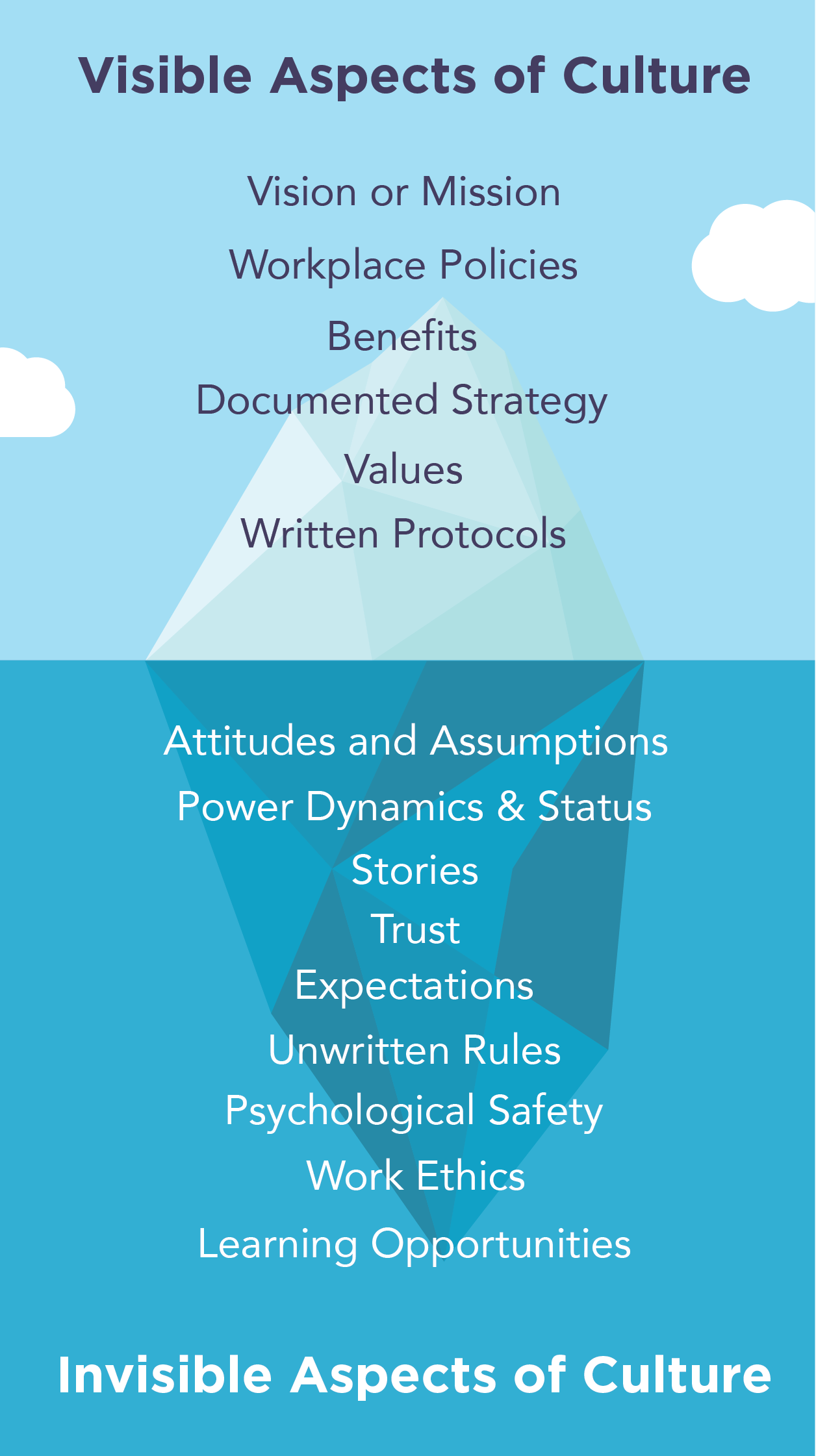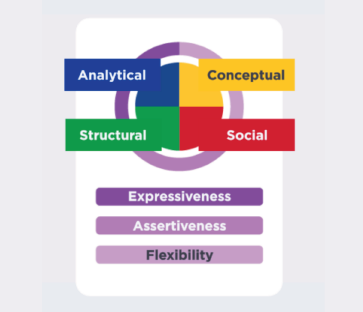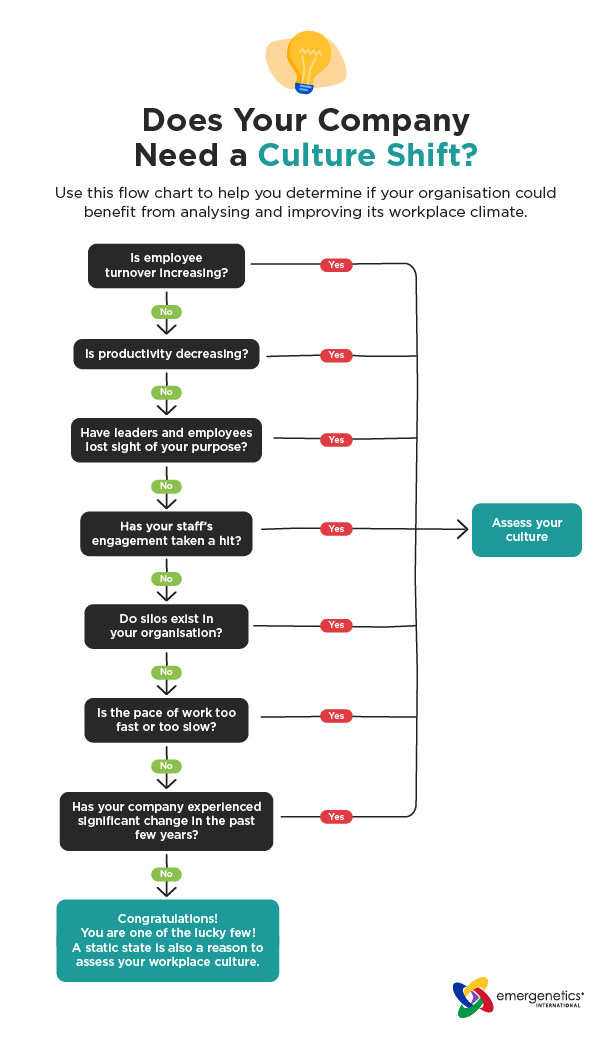The essential element of an inspired business strategy
No two companies have the same culture. Even if companies are in the same sector, share a similar set of core values and focus on similar drivers of corporate culture, there will be inherent nuances in how their working environment comes to life because the people, experiences and practices that make up each company will be unique.

This is why a strong corporate culture can be a real competitive advantage for companies or, if managers are not careful, a disadvantage.
To create a positive culture that encourages employees to give their best, managers, HR managers and leaders play an important role in explaining how things work, walking the talk and setting an example for others.
Defining workplace culture
There are many ways to explain this concept. A popular definition of an organisation's culture comes from Great Place to Work, which describes it as follows:
How you do what you do in the workplace. It's the sum of your formal and informal systems, behaviours and values, all of which create an experience for your employees and customers.
The elements that make up formal systems include
- Mission statement and declared values
- Written protocols on the use of communication systems, social media, etc.
- Policies on issues such as performance management and diversity and inclusion
- Company rituals and traditions
- Benefits in the workplace
Informal systems take into account
- Underlying attitudes and assumptions that guide behaviour
- How the different functions and people interact and communicate with each other
- How employees feel at work
- Influence and power dynamics between individuals and groups
- Stories told

Another useful way of looking at culture is as an iceberg. The formal systems and mechanisms of culture tend to be fairly visible. They are written down, codified and shared when new talent is brought in, or on company websites as part of the employer brand identity. The other part of the culture lies beneath the surface. It consists of all the informal, unwritten rules and systems that guide the way people work within the company.
Ideally, the formal, informal, visible and invisible elements of the culture are aligned. When there is a direct link, employees tend to be clear about the best ways to interact and get their work done. Where there is no alignment, confusion often sets in, particularly for new workers, and employees can become jaded by different expectations and norms, both overt and covert.
The importance of corporate culture
Most employers understand the negative effects of a toxic culture. This type of working environment often increases burnout, undermines employee wellbeing and reduces employee engagement. Ultimately, such cultures lead to increased staff turnover, lower productivity and poor performance for individuals and the business as a whole.
On the other hand, a positive corporate culture has a significant influence on the organisation:
- Impact on employees
- Company performance
- Hiring
Impact on employees
77% of employees say that a strong corporate culture helps them to perform at their best, and 76% say that a positive culture boosts their productivity and effectiveness. There is also a significant correlation between a pleasant working environment and high employee engagement, which translates into lower turnover.

Company performance
88% of employees and 94% of managers believe that a strong corporate culture is essential to business success, and the data proves them right. In addition to employees being more productive and motivated, engaging corporate cultures also tend to have higher levels of innovation (by around 30%) and increased turnover growth.

Hiring
46% of jobseekers consider organisational culture to be very important when choosing a company to apply to, and 35% say they would give up their ideal job if the company culture wasn't right for them. To attract the best talent, it's essential to devote time and energy to creating a positive company culture. As well as boosting recruitment practices, sharing your culture will help attract even better candidates, as people are likely to choose their future roles based on cultural fit.
With all these advantages, it's hardly surprising that the adage "culture eats strategy for breakfast" is still true today!
Cultural revolutions Motivating cultural change
While creating a positive corporate culture has been a topic of conversation for years, it is becoming increasingly important in the light of a number of developments.
Generational change
From a generational perspective, corporate culture is vital for millennials and Generation Z. Compared to previous age groups, workers from these generations tend to prioritise culture and value having a sense of purpose at work over a pay cheque. While pay certainly has a significant impact on hiring, younger employees are increasingly looking to join companies where work-life balance is a priority, where employees have a voice and where people are trusted to function autonomously. Companies that do not offer an attractive and flexible working environment have little chance of attracting new talent.
It's important to note that, although millennials and Generation Z are most vocal about their desire for a strong culture, they are not alone. 92% of employees say that culture has an impact on their decision to stay with an employer. Even if the younger generations are the most vocal, working conditions are important to everyone.
Changes in mindset
2020 and the challenges posed by the pandemic led many people to re-evaluate what mattered most to them. Changing attitudes and mindsets have led to the Great Resignation, and a toxic culture has been the main predictor of attrition. Employees are looking for a work environment where they will be valued, heard and given the opportunity to develop, so an unhealthy culture will no longer be tolerated.
In the wake of the great resignation has come the trend towards silent resignation. Most staff who resign quietly do so because of burnout and an unreasonable workload. Rather than continuing to do more for the company, employees are choosing to focus on the essentials and disengage from the extra work. If this trend continues, leaders should take it as a sign that they need to assess their corporate culture for signs of unhealthy expectations.
Factors influencing organisational culture
Employee experience is influenced by many factors, which explains the great diversity of working environments around the world. Here are some of the main factors that can contribute to or detract from a positive corporate culture.
The people
At the heart of a company's culture are the people within it. Leadership teams and managers often have the most influence on how the corporate culture is experienced; however, the environment can also be influenced by the different personalities, personal values, beliefs and experiences of the people who are employed. For better or worse, each individual can have an impact on the company's ethos.
Fundamental values and philosophies
While a company's values are often clearly stated, the philosophies that support or hinder the defined practices may not be so openly defined. The beliefs and principles that individuals bring to the organisation, and the way in which these philosophies are lived out, can affect the corporate culture that is created.
Hierarchy
Most companies have an organisational structure, which can be very formal or adopt more of a network approach. The value that different team members and the company place on a hierarchical, adhocratic or intermediate culture will have an effect on employees' attitudes and the way they behave and interact with each other.
Subcultures
Often, as businesses grow, teams, departments and divisions may start to develop their own practices, rituals and norms. The actions can certainly contribute to a positive workplace culture, or they may cause confusion and diminish the work culture if they run counter to the beliefs and tenets of the organization.
Location
The rise of hybrid working has certainly influenced the culture. The most obvious impact has been on the working environment itself, with many employees working remotely. The geographical displacement of employees has necessitated a transformation of the formal and informal systems that businesses use to communicate, collaborate and coordinate.
The essential elements of a positive corporate culture
To support a successful business strategy, start by focusing on the nine essential ingredients of an engaging organisational culture.
The reason for being in the workplace
Creating a common vision and a sense of shared values with employees will inspire a positive working culture. To cultivate a climate of engagement, employers need to be aware that their statement of intent must be about more than money. It must motivate, inspire and align employees.
Instilling a sense of belonging
Individual differences can be a source of strength for companies. After all, diversity of thought increases innovation, problem-solving and productivity. When companies create a space where they genuinely encourage employees to be themselves, train staff to eliminate unconscious bias and welcome all elements of a diverse population, including cognitive differences, race, gender and sexual orientation, the culture and its people will benefit.
Holistic benefits
Taking a holistic view of wellbeing will help to strengthen cultures. As employee expectations evolve, they are looking for fair compensation and holistic benefits that address their physical, mental, emotional, social and financial needs. By honouring the whole person, companies will get a positive return on their corporate culture.
Communication for workplace culture
Providing employees with regular communication from the management team and empowering managers to provide transparent information about the business will foster a positive corporate culture. It is also essential to provide feedback loops that encourage employee expression. When staff can share their difficulties and suggestions, they feel more committed and companies benefit from new ideas.
Amplifying recognition
All members of staff appreciate feeling valued and celebrated. That's why many employers invest in recognition programmes, designed to acknowledge the excellent work of their employees. By celebrating milestones in small and large ways, employees feel a sense of achievement and companies often see a reduction in turnover.
Cultivating meaningful relationships
Building strong relationships is essential to a positive corporate culture. A sense of community encourages people to come forward if they are struggling or feeling uncomfortable. It helps to improve results and performance by enabling staff to work together effectively. It also makes work more fun! Take the time to do small reviews and regularly reinforce team spirit.
Supporting employee development
According to LinkedIn, learning and development opportunities are the number one driver of a great culture. Employees want to learn new skills, progress in their careers and continue to acquire new knowledge. When companies invest in their people, they see an improved working environment through better performance and happier employees.
Increasing autonomy to promote work-life balance
Staff want to feel empowered to do their job and make a meaningful contribution to the organisation. While some companies have recently turned to technology companies that monitor computer clicks and engage in other forms of extreme corporate surveillance, forward-looking employers will focus instead on how they can train staff to maximise productivity while respecting work-life balance and individual expertise.
Promoting a culture of compassion
When employers do all of the above, they demonstrate that they value their employees. Another dimension is essential to positive corporate cultures: compassion. When staff feel that the management team and its leaders genuinely care about them as individuals, it encourages loyalty and helps them to perform at their best.
Do you want specific strategies for creating a stronger corporate culture?
A look at corporate culture through the attributes of Emergenetics

Emergentism offers another perspective for understanding what people are likely to expect from their workplace culture. Everyone has their own preferences in terms of how they think and behave. These tendencies have a direct impact on the types of experiences and priorities they value most in a professional environment.
Attributes of thought
Analytical
This attribute generally prioritises results. When you're designing your workplace culture, it's useful to describe the value they'll get from being part of the company, whether that's developing their expertise, improving benefits or something that fits with their value system.
Structural
Structural thinking is often associated with an interest in order. This does not mean that they are necessarily attracted to a hierarchical culture. On the contrary, people with this preference are likely to engage in a work culture where expectations are clear and achievable, and where responsibility is valued, whatever the organisational structure.
Social
This attribute generally focuses on the human aspect of the company. They are likely to feel energised by a corporate culture where individuals are cared for and where they have the opportunity to build strong relationships with each other.
Conceptual
The conceptual attribute often feels linked to big ideas. A positive culture in this respect would include a convincing long-term vision and the opportunity to experiment as part of their work.
Behavioural attributes
Expressiveness
Expressivity describes how people prefer to share their thoughts and feelings. Some people tend to be talkative, while others are more introspective. To create supportive work environments, we need to think about how individuals have the opportunity to share their ideas, contributions and challenges through a multitude of channels.
Self-assertion
This attribute reflects the style and pace with which people prefer to advance their ideas and beliefs. Some employees may prefer an energetic approach, while others may tend to keep the peace. Leaders can assess the type of work culture they are promoting by ensuring that they develop norms that allow both sides of this spectrum to flourish.
Flexibility
Flexibility explains how individuals react to imposed changes. Some innately prefer to keep their options open, while others prefer to stay the course. Look at your working environment in this light by reflecting on its attitude to the adhocracy culture, changes in the market and the way in which the company evaluates and incorporates its employees' recommendations.
The people who drive corporate culture
Each individual has an impact on how a company's ethos is put into practice. It is therefore important to understand the different mechanisms that each group can focus on to encourage a positive working culture.

The role of human resources
HR is often the guardian of corporate culture. It plays a crucial role in implementing values and ethics through a transparent policy, by creating reward and recognition structures that stimulate employee commitment and by designing performance management systems that ensure that individuals respect the company's principles.
The role of learning and development
To quote this statistic, opportunities to grow and learn are the number one driver of corporate culture. By investing in programmes to support professional development, an organisation shows that it values its people. By taking the time to understand training needs and developing attractive programmes, the L&D department will play an extremely important role in supporting a positive corporate culture.
The role of managers
When management teams are defining the strategic direction of the business, culture needs to be at the heart of their thinking. Leaders not only need to model the behaviours they want to see, but also demonstrate how culture and values influence decision-making at the highest level.
The role of managers
Supervisors have a significant impact on the strength of the corporate culture. They are the ones who bring to life the strategic direction as well as the HR and L&D policies for individual teams. They also spend the most time with employees. They must have the training and tools they need to live and breathe the company culture.
The role of employees
If all the above-mentioned people embody the company's culture, employees will find it easier to do so themselves. That said, they also influence each other. Provide staff with the resources to participate in and influence the workplace culture through traditions, recognition programmes, committees, etc.
When to assess a company's culture
Perhaps obvious solutions come to mind on the basis of the cultural considerations listed above, or perhaps you're not entirely sure what adjustments need to be made to improve the status quo.
To know whether it's time to initiate change, ask yourself the following questions:
- Is staff turnover increasing?
- Is productivity falling?
- Have managers or employees lost sight of the organisation's objective?
- Has employee commitment declined?
- Are there silos in your organisation?
- Is the pace of work too fast or too slow?
- Has your company undergone any major changes in recent years?
If you answered 'yes' to any of these questions, it's probably time to assess your current culture. If you answered 'no' to each of the above questions, particularly the one about change, it may be worth considering whether your culture is too risk-averse, as this may be another reason to examine your environment.
You may wish to get a second opinion on these issues. So please copy and share the flowchart image below with anyone else in your company whose opinion you would like to hear.

While it may seem insurmountable to re-evaluate your company's culture, it can be useful to start by identifying some opportunities for improvement. Take the time to talk to staff and management to analyse your company's performance on the nine essential elements of corporate culture:
- Objective
- Membership
- Benefits
- Communication
- Recognition
- Connection
- Growth
- Autonomy
- Compassion
In a simple survey, managers, executives and staff can rate the elements of the corporate culture on a Likert scale. This brief assessment will enable you to identify the strengths of your corporate culture as well as the opportunities for improvement. You may also find that some audiences rate each category differently. This information is just as important, as it can highlight discrepancies in the effectiveness with which your company lives its ethics.

Create a positive culture for your staff with Emergenetics
Another way to start building a new culture for your company is to partner with the Emergenetics International team. We specialise in creating a positive workplace for businesses, non-profit organisations, educational institutions and government entities. Through the language of grace and our programmes, we transform cultures to foster psychological safety, appreciation and productivity.
The language of grace
At Emergenetics, we believe in the power of strength-based language, or what we call the language of grace. This practice focuses on using vocabulary with positive connotations and can have ripple effects throughout the organisation.
Numerous studies have shown the health benefits of positive thinking, including longer life expectancy and improved physical and psychological well-being. As well as the positive feeling a person can get from using an affirmative vocabulary, it has also been shown to improve motivation and performance.
The language of grace is embedded in Emergenetics through our reports, essential workshops and digital courses, and can drive motivating change in your work culture.
Emerging programming
To foster a positive company culture, our essential workshops allow employees to take the Emergenetics profile and participate in a fun and engaging workshop to learn more :
- The thinking and behavioural preferences of themselves and their colleagues,
- The brilliance that comes from each of these attributes,
- The power of cognitive diversity and
- The language of grace
Participants also have access to the Emergenetics+ mobile application, which provides them with the following resources for promoting welcoming corporate cultures:
- Connexions, where employees can discover tips for improving communication and collaboration with colleagues who also have an Emergenetics profile.
- Saved groups, which provide information on team dynamics and strategies for working together productively.
- Attribute guides in action, which describe how individuals can use Emergenetics attributes to tackle common workplace challenges, such as conflict resolution, problem solving, goal setting, etc.

This advice enables people to connect in a way that honours each person for exactly who they are, fostering a sense of belonging, positive communication and strong relationships in the workplace. Companies can build on this learning in a number of ways, including through team workshops or our range of digital learning solutions. Our train-the-trainer model also provides HR, R&D and OD professionals with the tools to deliver Emergenetics programmes, integrate reflection and behaviour into their learning and development offerings and apply the language of grace in their own programmes.


